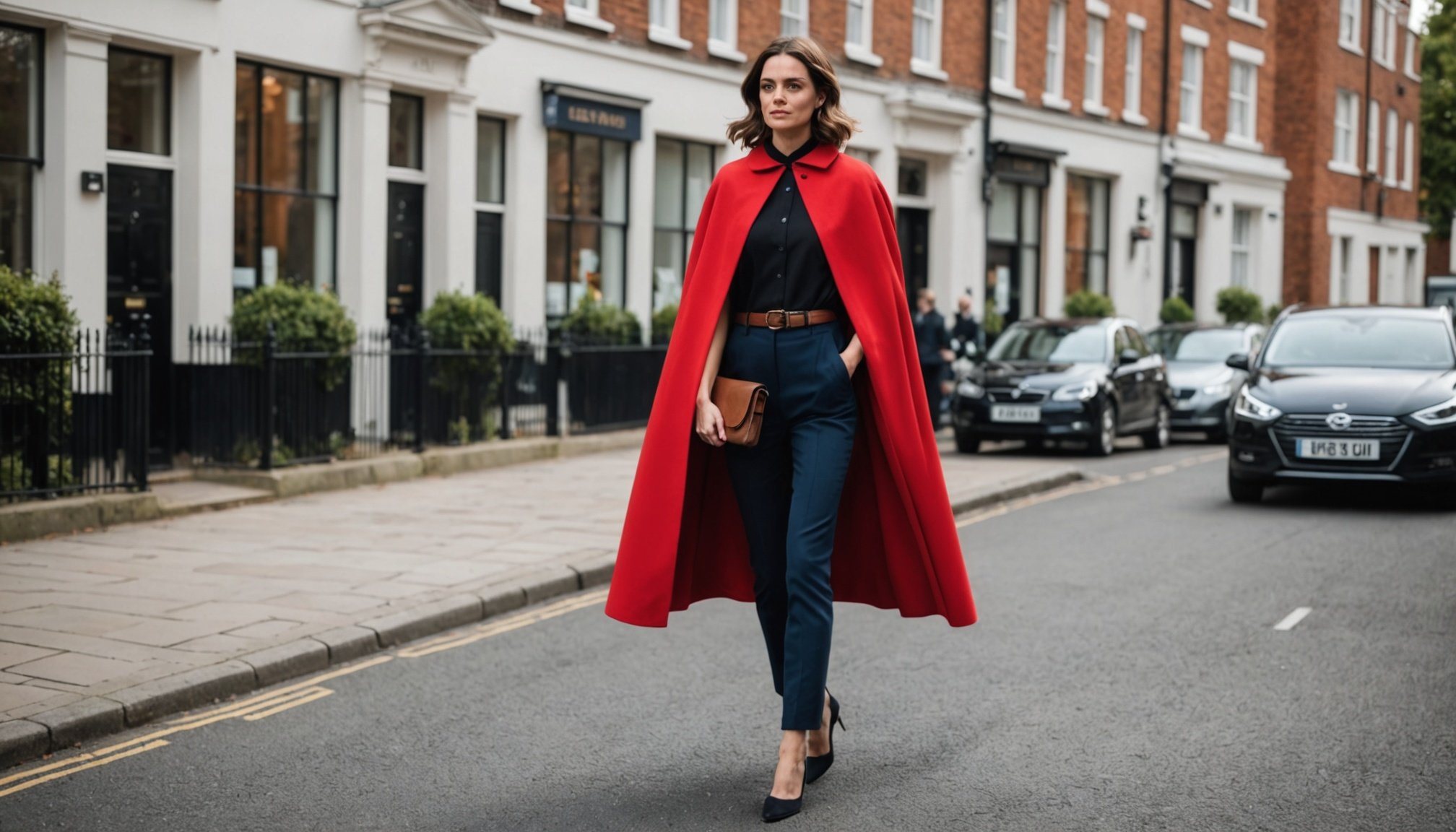Understanding Cape Fashion in the UK
Cape fashion, an integral part of UK Style, has evolved significantly over centuries. Historically, capes were not only functional attire during the British medieval period, offering warmth and protection, but they were also emblematic in British royalty and military uniforms. This evolution showcases the enduring adaptability and allure of capes in the fashion landscape.
In contemporary UK style, capes have made a remarkable comeback, driven by both practical needs and their fashion versatility. Movies and popular media have reintroduced capes as stylish and functional pieces. Today, luxury fashion houses and high-street brands alike incorporate capes into their collections, emphasizing their timeless appeal.
Also to discover : Discover the Best British Designers Crafting Unique Bespoke Maternity Fashion
Modern influences in cape fashion are also seen in the adaptations for urban life. Lightweight fabrics and innovative designs combine tradition with modern sensibility. The trend reflects an ongoing appreciation and reinvention of historical garments to fit present-day styles. Capes now often feature in fashion weeks, and are embraced by fashion-forward individuals seeking a statement piece.
The resurgence of cape fashion in the UK reinforces its standing as a versatile and chic style option, merging rich history with current fashion trends. Whether adorned for warmth or as a bold fashion statement, capes continue to be an iconic element of UK style.
Also to discover : Revamp your cold-weather look: creative tips to infuse neon hues into your uk winter wardrobe
How to Select the Right Cape
When choosing a cape, it’s vital to consider both fabric and fit. Different fabrics are suitable for different seasons. For autumn and winter, opt for heavier fabrics like wool or cashmere. They provide warmth and comfort. In contrast, lighter materials such as cotton or linen are ideal for spring and summer, offering breathability.
The fit and silhouette of a cape are just as crucial as the fabric. Consider your body type when selecting a cape to ensure it complements your figure. Capes with a defined waistline can enhance an hourglass shape, while those with a looser fit may suit a more rectangular body.
Furthermore, the occasion dictates the style of the cape. For casual events, a cape with simple lines and minimal embellishment works best. These keep the look relaxed yet stylish. On the other hand, for formal occasions, opt for a cape with intricate detailing or a luxurious fabric. These features can elevate your ensemble, lending a touch of elegance.
In summary, selecting the right cape involves careful attention to fabric and fit, tailored to both body type and occasion.
Styling Capes for Various Occasions
Capes may not always come to mind as a staple but, when styled correctly, they can transform any look.
Casual Looks
For a casual vibe, incorporating a cape outfit combination with your everyday attire can be effortlessly chic. Try pairing a light cape with jeans and a pair of worn boots for a laid-back yet refined appearance. Layering techniques are key here: wear a snug-fitting long-sleeve shirt beneath your cape to maintain a relaxed, cosy feel.
When considering accessories, opt for a minimalist approach. Simple earrings or a delicate necklace can enhance casual cape looks without overwhelming them.
Work Attire
Capes can seamlessly integrate into your professional wardrobe while providing a balance of sophistication and comfort. Stick to neutral tones like blacks, greys, and nudes, which are excellent styling tips to convey professionalism. Consider patterns such as subtle checks or pinstripes to add a fashionable edge.
For a polished finish, ensure your cape is structured. Pair it with tailored trousers or a pencil skirt for a confident and authoritative presence in the office arena.
Evening Wear
Incorporate elegant styling options for an evening engagement. Capes paired with long dresses or tailored suits create an ethereal impression. Opt for statement accessories such as sparkly clutches or dazzling earrings to provide a touch of glamour and complete the evening cape ensemble.
Dos and Don’ts of Wearing Capes
The cape’s charm is undisputed, but to embrace its full potential, adhering to specific Cape Styling Guidelines is crucial. Fashion advice prominently suggests that the proper cape choice begins with considering the garment’s length. As a rule of thumb, ensure it complements your body shape without overwhelming your frame. Shorter capes are generally versatile, while longer ones offer drama if styled correctly.
Equally important is the balance of proportions. Pair voluminous capes with fitted clothing to avoid a bulky appearance. Contrasting silhouettes can highlight the cape’s unique qualities without losing your shape beneath layers. Choosing complementary colours also plays a vital role. Opt for hues that blend well with your existing wardrobe, ensuring a cohesive and chic look.
On the other hand, common pitfalls abound, such as over-accessorising. The cape itself acts as a statement piece; hence, simplicity in accessories is advised. Additionally, avoid pairing capes with equally bold pieces, as this can result in an over-the-top ensemble. Lastly, remember the function of the cape—opt for thick, warm fabrics in colder climates, and light, airy materials for milder weather. Balancing these elements guarantees a poised and stylish appearance.
Visual Inspiration: Lookbooks and Examples
A curated lookbook provides a treasure trove of versatile cape outfits that serve as a great source of fashion inspiration. Examination of these collections illuminates the various ways capes have been effectively utilized by influential figures in fashion, breathing life into the versatility of this timeless garment.
Fashion icons have long employed capes to make bold statements, each adding their unique twist to cape styles. From the dramatic and voluminous to sleek and minimalistic designs, curated lookbooks often spotlight these influential figures executing cape mastery.
Moreover, lookbooks frequently highlight how these stars adapt capes to different seasonal trends. For instance, during autumn, you might find heavy tweed capes, while delicate, lightweight versions prevail in spring collections. Deeply inspired by the fluidity and adaptability capes offer, designers frequently change materials and patterns to align with the shifting seasons.
Beyond aesthetic appeal, these lookbooks serve as a practical guide, showcasing how anyone can effortlessly incorporate cape styles into their wardrobe by drawing on these influential examples. Living proof of the garment’s flexibility, these galleries encourage readers to embrace capes, unlocking a world of stylistic possibilities tailored to their personal taste and the ever-changing fashion landscape.
Conclusion and Final Tips
Mastering Cape Style is not only about following established trends but also about making it your own. Throughout this guide, we’ve explored versatile ways to incorporate capes into your wardrobe. Remember, the key is to balance boldness with practicality, ensuring that each piece complements your personal style.
Cape Fashion Takeaways
-
Versatility: Capes can easily transition from casual day wear to elegant evening attire. Pair them with jeans for a laid-back look or dress them up with a sleek gown for a more formal appearance.
-
Personalisation: Add unique touches such as brooches or belts to reflect your personality. Mixing and matching textures or patterns can add depth to your outfit.
-
Experimentation: Don’t shy away from trying different lengths and fabric types. A short cape can work as a statement accessory, while a long, flowing cape might add drama and sophistication.
Finally, embrace your individual style and let the cape be an extension of your fashion expression. It’s about enjoying the process and confidently exploring what works best for you. By applying these tips, you’ll not only enhance your wardrobe but also cultivate a sense of fashion-forwardness.











